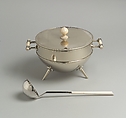On loan to The Met The Met accepts temporary loans of art both for short-term exhibitions and for long-term display in its galleries.
Tureen and ladle
Designer Christopher Dresser British, Scottish
Manufacturer Hukin & Heath British
Not on view
The simple elegance of Dresser's iconic tureen and ladle reflect the strong affect the Japanese metalwork had on his approach to design. From the late 1870s until his death, Dresser gave great attention to the quality and nature of the materials used as well as to line—here, the strong horizontal of the banding echoes the flat lid and straight ivory handles. The linearity of the whole is further stressed by the very geometric ladle made in contrasting materials of silver plate and ivory. The beauty of the tureen lies in its overall form as well as its simplicity. The beautiful, according to Dresser, "must be truthful in expression, and graceful, delicate, and refined in contour, manifesting no coarseness, vulgarity, or obtrusiveness. . . the beautiful manifests no want, no shortcomings."
The tureen as well as other "undecorated" metal objects that Dresser designed is remarkably similar to objects that he had seen in the imperial collection of the Shoso-in treasure house in Nara and in the Imperial Palace, Kyoto, on his trip to Japan.
Hukin & Heath hired Dresser as art advisor around 1878 and continued to use his designs until the turn of the twentieth century. This tureen, produced in different sizes, was manufactured in sterling silver as well as in silver plate.
Due to rights restrictions, this image cannot be enlarged, viewed at full screen, or downloaded.

